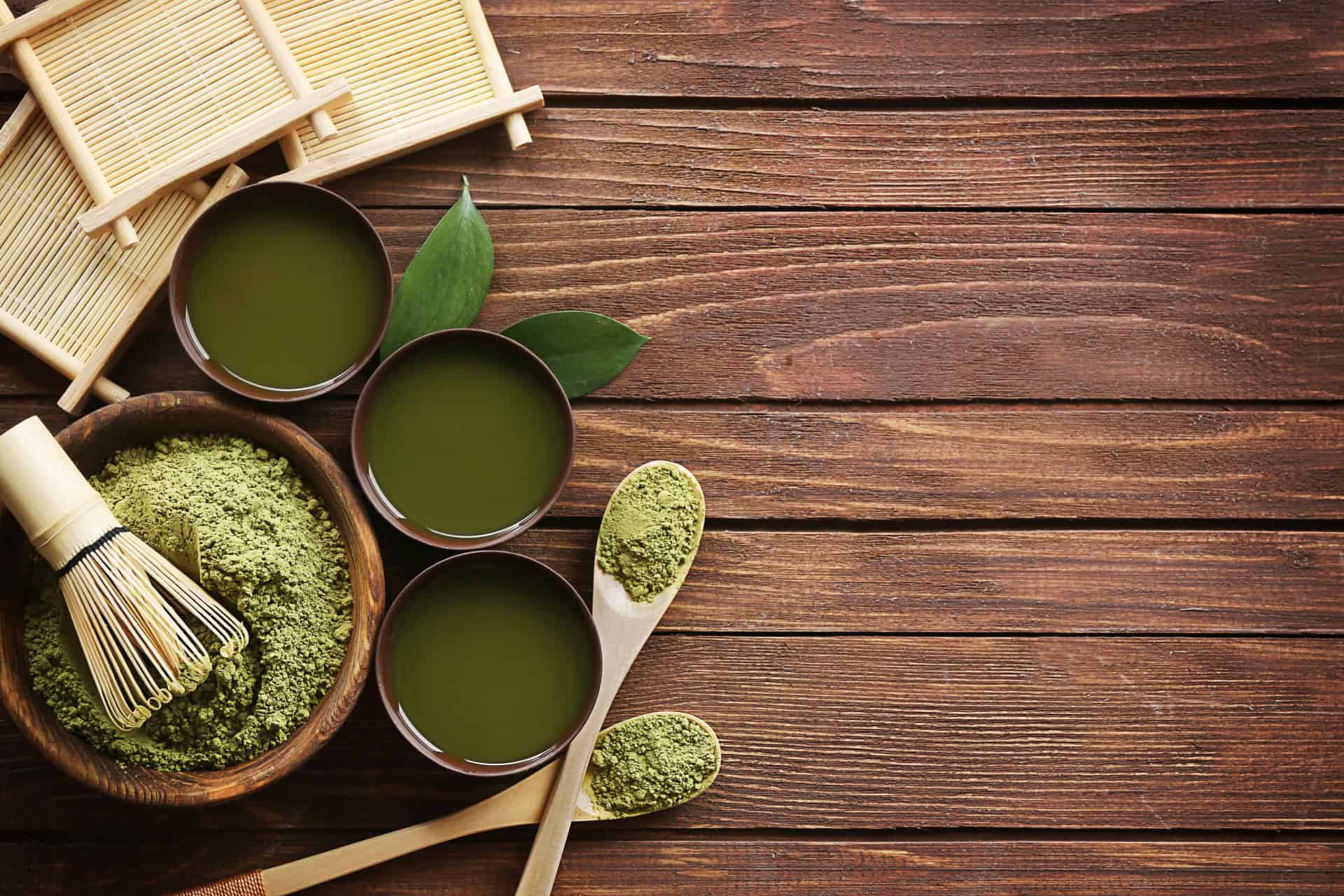Matcha tea has recently grown in popularity due to its antioxidant, inflammation, gut, and skin benefits, especially for anyone looking to help treat acne breakouts.
Although matcha may seem like just another “green tea,” it’s a verified superfood that can help with numerous bodily functions, including metabolism, skin health, immune support, and much more. Not only does matcha tea have over three times the amount of antioxidants found in regular green tea, but it also reduces it is also anti-inflammatory, fights insulin resistance, and protects your skin from sun damage more effectively. Unsurprisingly all of these benefits make matcha a great tea for clearing acne breakouts.
In this article, we will review the 5 primary ways matcha tea can help treat and prevent acne breakouts.
1. Matcha is packed with powerful antioxidants
Consuming plenty of antioxidants is crucial for fighting squalene oxidation, one of the root causes of acne.
Squalene oxidation occurs when the oil found on your skin (sebum) doesn’t have enough antioxidants and nutrients to fight off incoming threats, like chemicals, bacteria, UV exposure, and excessive oil production. Antioxidants help prevent squalene oxidation from happening in the first place, which allows your skin to maintain a healthy balance of having just enough oil to protect yourself from outside threats but not too much that it clogs pores.
Matcha tea is loaded with antioxidants that help regulate and protect the oil on the skin from oxidizing (turning bad and clogging the pore).
The main antioxidant found in matcha tea is epigallocatechin gallate or EGCG for short. EGCG helps prevent several of the root causes of acne, including:
- Decreased insulin resistance
- Lower production of sebum oil
- Decreased inflammation
- Protection from UV damage and free-radicals
One study even found that matcha green tea had 137x more EGCG antioxidants than one regular commercial brand of green tea, and 3x more antioxidants than any other type of green tea found in scientific literature (R). That’s a lot of antioxidants!
Because of its rich antioxidant profile, there’s hardly a process of the acne-formation process that isn’t in some way helped by the consumption of matcha and EGCG.
2. Matcha lowers insulin resistance
Insulin is the master hormone that’s released when your blood sugar level rises after eating a meal. It helps the sugar (glucose) in the bloodstream get absorbed by all the muscles and cells that need it. Unfortunately, most of us consume too much sugar and carbohydrates, and our insulin levels are constantly elevated as a result. This leads to blocked pores, inflammation, and too much oil production on the surface of the skin.
Fortunately, EGCG (the antioxidant that matcha is loaded with) has been shown to naturally lower insulin resistance and significantly help with the absorption of glucose (R). This is a huge win for clear skin, and yet another reason matcha can be critical in your journey towards clear skin.
3. Matcha is anti-inflammatory
Inflammation is what causes those nasty, red, angry pimples and whiteheads. Pimples emerge from simple, relatively harmless acne infections that occur when a pore gets blocked. A pimple is your body’s natural defense mechanism against this basic infection.
As I talk about here, most acne-sufferers also have chronic inflammation due to an unbalanced diet, so your body treats just about any minor infection (like acne) as a dangerous threat. The result is an endless cycle of inflammation and infection that leaves your face in red and with pimples.
Yet again, matcha tea comes to the rescue. The antioxidants found in green tea have been shown to decrease the release of pro-inflammatory cells in the body (R). Less inflammation means fewer pimples, whiteheads, and acne scars – another huge pro of drinking matcha.
4. Matcha promotes a healthy gut
Our modern diets are full of foods that destroy our digestive system. Wheat, pasta, corn, and some legumes all contain anti-nutrients called lectins that wreak havoc on the gut. An unhealthy gut can lead to leaky gut syndrome, which results in these anti-nutrients actually “leaking” into your bloodstream and triggering inflammation – and as a byproduct of this inflammation, you get, you guessed it, acne.
Luckily, matcha comes to the rescue yet again. Matcha contains large amounts of polyphenols – micronutrients that get broken down into gut-friendly bacteria. Not only do they improve gut health by creating beneficial probiotics, but they actively work to inhibit the growth of dangerous pathogenic bacteria in the gut.
5. Matcha lowers levels of hormones that cause acne
Insulin-like growth factor 1, or IGF-1, is hormone triggered by insulin and dairy consumption – it’s an absolute nightmare for acne.
Over the course of a few weeks, your skin goes through a natural process of shedding and replacing old skin cells. IGF-1 causes your skin to produce way too many cells, which rise to the surface of the skin and block the pore. A blocked pore is ripe territory for acne bacteria to swarm in and create an infection that can lead to acne.
EGCG limits IGF-1’s skin-damaging effects by directly blocking IGF-1 receptors and preventing them from ever getting overstimulated in the first place. EGCG also limits the production of sebum oil (R). This means you have a lower chance of getting a blocked pore in the first place.
What is the best type of matcha to buy for acne?
When buying matcha, or any tea for that matter, the quality counts – but, just like the decision to buy organic vegetables or grass-fed meats, it’s not within everyone’s budget to purchase the highest quality matcha.
The good news is that high-quality, organic, Japanese matcha is easy to come by and affordable.
There are two main grades of matcha:
- Ceremonial – Highest quality, made from youngest leaves, exclusively for tea
- Culinary – Lower quality, made for use with other ingredients or as tea
If you can afford it, a high-quality, organic, ceremonial matcha will often contain more antioxidants per gram – but the difference is less than you’d think. Here’s a comparison of two popular brands below:
- Jade Leaf Culinary Grade (~$0.20/gram)
- 130-140mg of catechins / gram
- 57-68mg of EGCG / gram
- Kenko Organic Ceremonial Grade (~$0.93/gram)
- 134mg of catechins / gram
- 70mg of EGCG / gram
The ceremonial grade barely inches out the culinary-grade in EGCGs despite being more than 4x the cost. This means that if you’re buying matcha for its skin-clearing benefits, an organic, Japanese-grown, culinary grade will do just fine. The taste will be a little more bitter than ceremonial-grade matcha, but if you can get past that you’ll still reap most of the health benefits.
There are a few things you want to watch out for when it comes to buying high-quality matcha:
- Make sure that it’s made in Japan – Lots of new Chinese matcha teas are springing up at a fraction of the cost of their Japanese counterparts. Why? They contain additives and often have more contaminants, like aluminum and fluoride, which are harmful to your overall health and can cause acne.
- Make sure it’s USDA-Certified Organic – This is a must-have for matcha, as it ensures that you avoid the pesticides and chemicals (especially fluoride) that can lurk in otherwise healthy foods and cause you to break out. Organic brands of matcha aren’t hard to come by, and they’re really not much more expensive.
- Make sure it’s safety tested – Certain teas can contain radiation and harmful metals that cause serious health problems. Check the manufacturers closely to make sure proper safety testing for microbes, pesticides, heavy metals, and radiation are done.
Jade Leaf Culinary-Grade Matcha is the brand I swear by. It hits all three of the major boxes – 100% USDA organic, grown in Japan, and it’s free of heavy metals and chemicals like fluoride. Not only does it contain a high amount of EGCG’s per gram (57 – 68mg) and taste great, but it’s an affordable way to consume matcha on a daily basis. I simply add it to hot water and drink it as a tea or occasionally mix it in with a smoothie. I’ve found it to be a phenomenal coffee replacement that’s both better for my skin and my mental clarity. Matcha doesn’t come with the jitters, anxiety, or crash that coffee often does.
What are the general health benefits of matcha tea?
It’s hard to think of a drink with more health benefits than green tea, whether or not its matcha tea:
- Helps prevents cancer, diabetes, and Alzheimer’s
- Promotes proper bone and teeth health
- Protects the skin from UV damage
- Increased fat burning for weight loss
In addition to just generally improving your health, green tea also helps clear the skin by touching just about every root cause of acne there is, from insulin to inflammation.
Although the resurgence of matcha as a modern-day supplement is somewhat new, matcha leaves have been used for various health maladies for over 1,000 years, dating back to the Tang dynasty in China. It’s made from younger tea leaves that are shaded from the sun during their last few weeks of growth. This is what gives it that vibrant bright green color.

Matcha tea comes in powdered form and can be mixed into smoothies, baked into foods, or simply consumed as a hot or cold tea.
There are claims that matcha was the ancient drink of choice for both monks seeking calming energy during meditation as well as Samurai warriors looking for a zen pre-battle boost. While I can’t personally back up these claims, I can tell you firsthand that matcha tea not only packs quite the kick but also has improved my skin quite a bit.
Because it’s lower in caffeine than coffee, it’s a lot less likely to trigger the same stress hormones that cause acne. I still get just as much, if not more energy and focus from matcha, and the caffeine comedowns aren’t nearly as bad.
Being a form of green tea, matcha has all the same skin-clearing benefits of regular green tea, but because of its potency and quality, these benefits are enhanced and improved.
While it may be a bit more expensive, this edge can really make all the difference.
Conclusion
Thanks to its antioxidant properties, green tea, and more specifically matcha, can really be a lifesaver for clear skin.
Not only does it tackle all 4 root causes of acne, but its overall health benefits make it a no-brainer.
If you struggle with acne even after making massive dietary changes, coffee or other caffeine-dense drinks may just be the culprit – high amounts of caffeine can spike cortisol levels and increase stress, causing acne. Try replacing your morning cup of joe with matcha once a week and see if your skin improves – I find it to be more calming and energizing without the crashes and irritability of coffee, and I bet you will too.
Frequently Asked Questions
Matcha contains methylxanthines and EGCG which help stimulate circulation and decrease inflammation.
Matcha tea was originally created in the 8th century in Japan. Matcha is created by shading young tea leaves and mashing them up into a powder.


